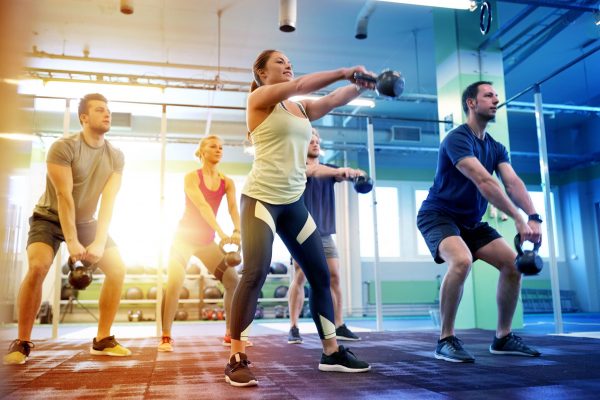Home>Misc>Featured>Why Do We Need Exercise And Athletic Performance


Featured
Why Do We Need Exercise And Athletic Performance
Modified: January 22, 2024
Improve your overall athletic performance by understanding why exercise is essential. Get featured tips and advice to enhance your athletic abilities.
Introduction
Exercise plays a crucial role in maintaining a healthy lifestyle and achieving optimal athletic performance. Whether you’re an avid sports enthusiast or simply looking to improve your overall well-being, incorporating regular exercise into your routine is essential. Not only does exercise contribute to physical health, but it also has a significant impact on mental well-being. From reducing the risk of chronic diseases to enhancing strength and flexibility, exercise offers numerous benefits that extend beyond the physical realm.
In today’s sedentary lifestyle, where technology has made our lives more convenient but less active, understanding the importance of exercise is critical. Engaging in physical activities not only helps us maintain a healthy weight but also boosts our cardiovascular health. Additionally, exercise has been proven to improve mental health by reducing stress, anxiety, and depression. It promotes the release of endorphins, the feel-good hormones that elevate our mood and contribute to overall happiness.
But exercise is not limited to maintaining a healthy lifestyle; it also plays a significant role in enhancing athletic performance. Athletes and sports enthusiasts recognize the importance of physical fitness for achieving their sporting goals. Regular exercise not only improves strength and endurance but also increases flexibility, speed, agility, balance, and coordination, allowing athletes to perform at their best on the field.
This article will explore the many benefits of exercise for both physical and mental health and discuss how it can enhance athletic performance. We will delve into the various ways exercise can improve strength, flexibility, and mobility, as well as the importance of preventing sports injuries. By understanding the significance of exercise and its impact on our overall well-being, we can make informed choices to incorporate it into our lives.
Importance of Exercise
Exercise is not just an optional activity; it is a fundamental component of a healthy lifestyle. Engaging in regular physical activity offers a myriad of benefits for both our physical and mental well-being.
One of the primary reasons exercise is important is its impact on physical health. Regular exercise strengthens our cardiovascular system, improves lung function, and boosts overall endurance. It can help lower blood pressure, reduce the risk of heart disease, and enhance the efficiency of our immune system.
Exercise also plays a critical role in maintaining a healthy weight. By burning calories and increasing metabolism, physical activity helps prevent weight gain and aids in weight loss. It promotes the development of lean muscle mass, which in turn helps to increase our metabolic rate and improve body composition.
In addition to the physical benefits, exercise has a profound impact on mental health. Engaging in physical activities stimulates the release of endorphins, which are natural mood elevators. Regular exercise has been shown to reduce symptoms of stress, anxiety, and depression, leading to improved overall mental well-being.
Moreover, exercise enhances cognitive function and improves memory and concentration. Physical activity increases blood flow to the brain, promoting the growth of new neurons and improving brain health. It has also been linked to a reduced risk of cognitive decline and age-related neurodegenerative diseases.
Furthermore, exercise is essential for preventing chronic diseases. Leading a sedentary lifestyle is a risk factor for conditions such as obesity, diabetes, and certain types of cancer. Regular exercise helps mitigate these risks and can significantly reduce the likelihood of developing chronic diseases.
Overall, exercise is an integral part of a healthy lifestyle, providing benefits for both our physical and mental health. By incorporating regular physical activity into our routines, we can improve our well-being, maintain a healthy weight, prevent chronic diseases, and enhance our cognitive function. The next sections will explore how exercise also plays a crucial role in improving athletic performance.
Physical Health Benefits
Regular exercise offers a multitude of physical health benefits that are crucial for overall well-being. From improving cardiovascular health to maintaining a healthy weight, physical activity plays a pivotal role in keeping our bodies in prime condition.
One of the most significant physical health benefits of exercise is its impact on the cardiovascular system. Engaging in aerobic exercises such as running, cycling, or swimming helps strengthen the heart and improve blood circulation. This, in turn, reduces the risk of heart disease, lowers blood pressure, and enhances overall cardiovascular fitness.
Exercise is also essential for maintaining a healthy weight. By engaging in physical activities, we burn calories and increase metabolism, which aids in weight loss and weight management. Regular exercise also helps build lean muscle mass, which contributes to a higher metabolic rate, allowing our bodies to burn more calories even at rest.
Furthermore, exercise plays a crucial role in improving bone density and strength. Weight-bearing exercises, such as walking, jogging, or weightlifting, stimulate the growth of new bone tissue and help prevent osteoporosis, a condition characterized by weakened and brittle bones.
Physical activity also enhances the efficiency of our immune system. Regular exercise increases the production of antibodies and white blood cells, which help fight off infections and diseases. By strengthening the immune system, exercise reduces the risk of common illnesses, such as colds and flu.
Another notable physical health benefit of exercise is its positive impact on the digestive system. Regular physical activity stimulates the muscles in the digestive tract, aiding in proper digestion and preventing common digestive disorders, such as constipation.
In addition to these benefits, exercise has been linked to a reduced risk of certain types of cancer, such as colon and breast cancer. Physical activity helps regulate hormone levels, reduces inflammation, and improves insulin sensitivity, all of which contribute to a lower risk of developing cancer.
In summary, engaging in regular exercise provides a wide range of physical health benefits. It improves cardiovascular health, helps in maintaining a healthy weight, strengthens bones, boosts immune function, enhances digestion, and reduces the risk of certain types of cancer. By incorporating physical activity into our daily routines, we can significantly improve our physical well-being and lead a healthier life.
Mental Health Benefits
Exercise not only benefits our physical health but also has a profound impact on our mental well-being. Engaging in regular physical activity can significantly improve our mood, reduce stress, and boost overall mental health.
One of the most notable mental health benefits of exercise is its ability to reduce stress and anxiety. Physical activity activates the release of endorphins, which are known as the “feel-good” hormones. These endorphins act as natural mood elevators, helping to alleviate stress and promote a sense of well-being.
In addition to reducing stress, exercise has been shown to decrease symptoms of anxiety and depression. It can increase the production of neurotransmitters such as serotonin and dopamine, which are involved in regulating mood and emotions. Regular exercise has been found to be as effective as medication or therapy in reducing symptoms of mild to moderate depression.
Exercise also plays a role in enhancing cognitive function and improving memory and concentration. Physical activity increases blood flow to the brain, which promotes the growth of new neurons and improves overall brain health. Studies have shown that regular exercise can boost cognitive function and may reduce the risk of cognitive decline and neurodegenerative diseases, such as Alzheimer’s.
Engaging in physical activity also provides an opportunity for relaxation and stress relief. Whether it’s going for a walk in nature, practicing yoga, or participating in a team sport, exercise allows us to take a break from the daily stressors and focus on the present moment. This can have a calming effect on the mind, improve mental clarity, and enhance overall well-being.
Furthermore, exercise can improve self-esteem and body image. Regular physical activity helps to improve body composition, increase muscle tone, and enhance physical fitness. These changes can boost self-confidence and promote a positive body image, leading to improved overall self-esteem.
In summary, exercise has numerous mental health benefits. It reduces stress and anxiety, alleviates symptoms of depression, enhances cognitive function, provides relaxation and stress relief, and improves self-esteem and body image. By incorporating regular physical activity into our lives, we can reap the mental health benefits and experience improved overall well-being.
Maintaining Healthy Weight
Maintaining a healthy weight is a key component of overall well-being, and exercise plays a crucial role in achieving and sustaining it. Regular physical activity helps burn calories, increases metabolism, and contributes to weight management.
One of the primary ways exercise helps in maintaining a healthy weight is by burning calories. When we engage in physical activities such as brisk walking, jogging, or cycling, our bodies expend energy, leading to the burning of calories. The more intense the activity, the more calories are burned.
Exercise also increases metabolism, which is the rate at which our bodies convert food into energy. Regular physical activity helps to stimulate our metabolism, even at rest and during sleep. An increased metabolic rate allows us to burn more calories throughout the day, making it easier to maintain a healthy weight.
In addition to burning calories and increasing metabolism, exercise helps to build lean muscle mass. When we engage in strength training exercises, such as lifting weights or doing bodyweight exercises, our muscles are challenged and stimulated to grow stronger. As muscles are more metabolically active than fat, having a higher proportion of lean muscle mass can help increase our metabolic rate, making it easier to maintain a healthy weight.
Furthermore, exercise plays a crucial role in preventing weight gain and aiding in weight loss. By engaging in regular physical activity, we can create an energy imbalance where the number of calories burned through exercise exceeds the calories consumed through food. This energy deficit leads to weight loss, while regular exercise helps to prevent weight gain by balancing energy intake and expenditure.
Maintaining a healthy weight is not just about the number on the scale; it is also about body composition. Regular exercise helps to improve body composition by reducing body fat and increasing muscle mass. This results in a healthier and more desirable body shape, enhancing overall physical appearance and boosting self-confidence.
In summary, exercise plays a vital role in maintaining a healthy weight. It helps burn calories, increases metabolism, aids in weight loss, prevents weight gain, and improves body composition. By incorporating regular exercise into our routines, along with a balanced and nutritious diet, we can achieve and sustain a healthy weight, leading to better overall health and well-being.
Preventing Chronic Diseases
Regular exercise is a powerful tool in preventing chronic diseases and improving overall health. Leading a sedentary lifestyle is a significant risk factor for various health conditions, but incorporating physical activity into our routines can significantly reduce these risks.
One of the primary benefits of exercise in preventing chronic diseases is its impact on cardiovascular health. Regular physical activity strengthens the heart, improves blood circulation, and lowers blood pressure, reducing the risk of heart disease and stroke. Engaging in aerobic exercises, such as brisk walking, swimming, or cycling, can help maintain healthy cholesterol levels and reduce the chances of developing cardiovascular conditions.
In addition to cardiovascular health, exercise plays a crucial role in preventing and managing type 2 diabetes. Engaging in physical activity helps improve insulin sensitivity, allowing our bodies to use glucose effectively. Regular exercise also helps to maintain a healthy weight, which is essential in preventing and managing diabetes. By lowering blood sugar levels, reducing insulin resistance, and promoting overall metabolic health, exercise can have a significant impact on preventing this chronic disease.
Cancer is another chronic disease that regular exercise can help prevent. Numerous studies have demonstrated a link between physical activity and a reduced risk of certain types of cancer, such as colon, breast, and lung cancer. Exercise helps regulate hormone levels, reduce inflammation, boost the immune system, and improve overall body composition, all of which contribute to a lower risk of developing cancer.
Furthermore, exercise can prevent and manage chronic respiratory diseases, such as chronic obstructive pulmonary disease (COPD) and asthma. Regular aerobic exercise, combined with specific breathing exercises, can improve lung capacity, enhance respiratory muscle strength, and reduce symptoms of these conditions.
Engaging in physical activity also helps to prevent osteoporosis, a condition characterized by low bone density and an increased risk of fractures. Weight-bearing exercises, such as walking, jogging, or weightlifting, stimulate the growth of new bone tissue and promote bone strength, reducing the risk of developing osteoporosis later in life.
In summary, regular exercise is a powerful tool in preventing chronic diseases. It helps to improve cardiovascular health, prevent and manage type 2 diabetes, reduce the risk of certain types of cancer, prevent respiratory diseases, and promote bone health. By incorporating physical activity into our routines, we can significantly reduce the risks of chronic diseases and improve our overall health and well-being.
Enhancing Athletic Performance
Exercise not only benefits our overall health but also plays a critical role in enhancing athletic performance. Whether you’re a professional athlete or a recreational sports enthusiast, incorporating regular exercise into your training routine can help you reach new heights and achieve your sporting goals.
One of the key ways exercise enhances athletic performance is by improving strength and endurance. Strength training exercises, such as weightlifting and resistance training, help increase muscle strength and power. This, in turn, improves performance in various sports and activities that require explosive movements or the ability to generate force.
Cardiovascular exercises, such as running, swimming, or cycling, help improve endurance by increasing the oxygen-carrying capacity of the muscles. Regular aerobic exercise improves cardiovascular fitness, allowing athletes to sustain higher levels of intensity for longer durations without fatigue.
Flexibility and mobility are also vital components of athletic performance. Incorporating stretching exercises, yoga, or Pilates into your training routine can help improve flexibility, allowing for a greater range of motion in joints and muscles. Enhanced flexibility and mobility can improve athletic performance in sports that require agility, coordination, and quick movements, such as gymnastics or martial arts.
Speed and agility are essential in many sports, and exercise can significantly enhance these qualities. Performing sprint intervals, agility drills, and plyometric exercises can help develop fast-twitch muscle fibers, improve reaction time, and enhance speed and agility on the field or court.
Moreover, exercise improves balance and coordination, which are critical in sports that require precise movements and control, such as gymnastics or ballet. Incorporating exercises that challenge balance, such as yoga poses or balance drills, can significantly improve these skills and contribute to overall athletic performance.
Another significant benefit of exercise in enhancing athletic performance is injury prevention. Regular physical activity helps strengthen muscles, tendons, and ligaments, reducing the risk of sports-related injuries. Additionally, exercises that focus on stability and core strength can improve posture and form, further reducing the likelihood of injury.
In summary, exercise plays a vital role in enhancing athletic performance. It improves strength and endurance, increases flexibility and mobility, enhances speed and agility, improves balance and coordination, and reduces the risk of sports-related injuries. By incorporating a well-rounded exercise routine into your training regimen, you can maximize your athletic potential and excel in your chosen sport or activity.
Improved Strength and Endurance
Exercise is a powerful tool for improving both strength and endurance, two essential components of athletic performance. Whether you’re an athlete striving to excel in your sport or someone looking to enhance your overall fitness level, incorporating exercises that target strength and endurance can yield significant improvements.
Strength is the ability of your muscles to generate force. By engaging in resistance training exercises such as weightlifting or bodyweight exercises, you can increase your muscle strength and power. Resistance training involves lifting weights or exerting force against resistance, such as resistance bands or your own body weight. Over time, consistent resistance training stimulates muscle growth, increases muscle fiber recruitment, and improves overall strength.
In addition to increasing strength, exercise also enhances endurance. Endurance refers to the ability of your muscles to perform repetitive tasks over an extended period without fatigue. Cardiovascular exercises, such as running, cycling, or swimming, help improve endurance by increasing the efficiency of your cardiovascular system.
Regular aerobic exercise trains your heart to pump blood more efficiently and allows your muscles to utilize oxygen more effectively. This increased oxygen supply to your muscles delays the onset of fatigue, enabling you to perform at higher intensities and for longer durations.
Combining strength training with cardiovascular exercise can yield even greater improvements in both strength and endurance. Strength training exercises help develop the muscles needed for power and explosiveness, while cardiovascular exercises improve cardiovascular fitness and enhance muscle endurance. This combination is particularly beneficial for athletes participating in sports that require both strength and endurance, such as soccer, basketball, or martial arts.
Moreover, exercise improves muscular endurance, which is the ability of specific muscles or muscle groups to sustain effort or maintain a specific position. This type of endurance is crucial for activities such as long-distance running, cycling, or swimming. By engaging in exercises that target specific muscle groups and involve sustained effort, you can improve their endurance capacity.
Improving strength and endurance can have numerous benefits beyond athletic performance. It enhances overall physical fitness, allowing you to perform everyday activities with greater ease and efficiency. Having greater strength and endurance also reduces the risk of injuries, as your muscles and joints become more resilient to physical stress.
In summary, exercise is instrumental in improving both strength and endurance. Resistance training exercises increase muscle strength and power, while cardiovascular exercises enhance cardiovascular fitness and muscle endurance. By incorporating a combination of strength and endurance training into your exercise routine, you can experience significant improvements in athletic performance, overall fitness, and resilience to injuries.
Increased Flexibility and Mobility
Exercise plays a crucial role in improving flexibility and mobility, two essential components of physical fitness. Flexibility refers to the range of motion of your joints and muscles, while mobility refers to the ability to move freely and effectively.
Regular exercise, particularly activities that focus on stretching and range of motion, can significantly improve flexibility. Stretching exercises help lengthen and relax muscles, allowing them to move through a greater range of motion without discomfort or restriction. Incorporating stretching exercises such as static stretching, dynamic stretching, or yoga into your routine can help improve flexibility and enhance overall physical performance.
Increased flexibility offers many benefits. It can improve athletic performance by enhancing the efficiency of movements and allowing for greater joint mobility. In sports that require a wide range of motion, such as gymnastics or martial arts, flexibility is essential for performing complex movements and maintaining proper form.
Flexibility can also help prevent injuries. When muscles and joints have a greater range of motion, they are less likely to suffer from strains, sprains, or muscle imbalances. Improved flexibility allows muscles to absorb impact more effectively and reduces the risk of overstretching or tearing tissues during physical activity.
Aside from flexibility, exercise also enhances mobility, which is the ability to move freely and efficiently. Mobility is crucial for activities in daily life, such as bending, reaching, and lifting. By incorporating exercises that promote mobility, such as hip mobility exercises, shoulder mobility exercises, or full-body movements, you can improve functional movement patterns and overall physical performance.
Increased mobility can improve athletic performance in various sports that require agility, coordination, and quick movements. It allows for fluid and efficient movement, reduces the risk of injury, and enables athletes to perform at their best.
Besides athletic performance, improved flexibility and mobility can also enhance everyday activities. It allows you to move more freely, perform daily tasks with greater ease, and maintain good posture. Better mobility can also contribute to better joint health and reduce the risk of musculoskeletal conditions, such as chronic pain or arthritis, later in life.
In summary, exercise is key to improving both flexibility and mobility. Regular stretching exercises improve flexibility, allowing for a greater range of motion and enhancing athletic performance. Mobility exercises promote fluid and efficient movement, improving functional abilities for everyday activities. By incorporating exercises that target flexibility and mobility into your exercise routine, you can experience significant improvements in physical performance, injury prevention, and overall quality of life.
Enhanced Speed and Agility
Exercise plays a crucial role in improving speed and agility, two essential components of athletic performance. Whether you’re a sprinter, a soccer player, or simply looking to enhance your overall athletic abilities, incorporating specific exercises into your training routine can help you reach new levels of speed and agility.
Speed refers to the ability to move quickly over a specific distance, whereas agility involves the ability to change direction swiftly and efficiently. Both speed and agility are essential in various sports and activities, requiring quick reactions, rapid movements, and the ability to accelerate, decelerate, and change direction effectively.
One way to enhance speed and agility is through specific sprint training. Sprint exercises involve performing short-distance sprints at maximum effort, followed by sufficient rest periods for recovery. This type of training helps improve muscle power, stride length, and stride frequency, leading to enhanced speed and quick bursts of acceleration.
Incorporating interval training into your routine is also beneficial for enhancing speed and agility. Interval training involves alternating between periods of high-intensity exercise and recovery periods. This type of training helps increase cardiovascular fitness, improves anaerobic capacity, and enhances the ability to maintain high-speed efforts for longer durations.
Plyometric exercises, such as jump squats, box jumps, and lateral hops, are highly effective for improving speed and agility. Plyometrics focus on explosive movements that engage fast-twitch muscle fibers, which are responsible for quick and powerful movements. These exercises improve muscle strength, power, and reactive ability, allowing for rapid and efficient movements.
Agility ladder drills and cone drills are additional exercises that can greatly enhance agility. These drills involve quick footwork, changes of direction, and precision movements. Regularly practicing these drills can improve foot speed, coordination, and the ability to react quickly to changing situations, making you more agile in sports and activities that require quick movements.
In addition to specific exercises, improving speed and agility requires good overall fitness. Engaging in regular cardiovascular exercises, such as running, jumping rope, or cycling, can help improve cardiovascular fitness, muscle endurance, and overall stamina. This, in turn, allows for sustained speed and agility during activities that require prolonged efforts.
Incorporating strength training exercises alongside speed and agility training is also crucial. Building strength helps to improve force production, muscle control, and overall stability, all of which contribute to enhanced speed and agility. Exercises such as lunges, squats, and lateral movements target key muscle groups, helping to improve the ability to generate power and quickly change direction.
In summary, exercise is essential for enhancing speed and agility. Specific sprint training, interval training, plyometric exercises, and agility drills can significantly improve speed and agility. Additionally, overall fitness and strength training play a crucial role in supporting speed and agility development. By incorporating these types of exercises into your training routine, you can experience noticeable improvements in your speed and agility, leading to enhanced athletic performance in various sports and activities.
Improved Balance and Coordination
Exercise is instrumental in improving balance and coordination, two essential components of physical performance. Whether you’re an athlete looking to enhance your sport-specific skills or simply aiming to improve overall movement quality, incorporating exercises that target balance and coordination can yield significant improvements.
Balance refers to the ability to maintain control of your body’s position, whether stationary or in motion. It plays a crucial role in various activities, such as yoga, gymnastics, or martial arts. By incorporating balance exercises into your routine, such as single-leg exercises, yoga poses, or stability exercises on unstable surfaces, you can improve your ability to control your body’s position and maintain stability.
Improved balance not only enhances performance in specific sports but also reduces the risk of falls and injuries in daily activities. As we age, balance becomes especially important for preventing falls and maintaining independence. Engaging in exercises that challenge balance and proprioception can help improve stability and reduce the risk of falls, thereby enhancing overall quality of life.
Coordination, on the other hand, refers to the ability to perform movements with smoothness and precision. It involves the integration of different body parts and muscle groups to perform complex movements and tasks. Coordination is vital in sports that require fine motor skills, such as basketball, tennis, or dance.
Exercise plays a critical role in improving coordination by enhancing the connection between the brain, muscles, and nerves. Engaging in activities that require coordination, such as agility ladder drills, ball-handling drills, or dance classes, can significantly improve your ability to control movements and perform complex sequences.
Furthermore, exercises that focus on functional movements and full-body integration can help improve overall coordination. Exercises such as kettlebell swings, medicine ball exercises, or battle rope workouts require the synchronization and coordination of multiple muscle groups, developing a greater sense of body awareness and coordination.
Improved balance and coordination have numerous benefits beyond athletic performance. They contribute to better posture and body alignment, reducing the risk of musculoskeletal imbalances and associated injuries. Additionally, enhanced balance and coordination can improve daily activities such as walking, climbing stairs, or carrying objects more efficiently and with reduced risk of falls.
Finally, exercises that improve balance and coordination can also enhance cognitive function. The intricate connections required between the brain and muscles to perform coordinated movements can help improve neural pathways and cognitive processing. Studies have shown a positive correlation between physical coordination exercises and improved cognitive abilities, such as attention, memory, and problem-solving skills.
In summary, exercise is instrumental in improving balance and coordination. Specific balance exercises challenge stability and improve body control, reducing the risk of falls and enhancing performance in various activities. Coordination exercises improve movement precision and enhance overall motor skills. By incorporating exercises that target balance and coordination into your routine, you can experience significant improvements in these areas, leading to better athletic performance, reduced risk of injuries, and enhanced overall movement quality.
Preventing Sports Injuries
Exercise plays a vital role in preventing sports injuries and ensuring the safety and well-being of athletes. Engaging in regular physical activity, along with proper warm-up and cool-down routines, can significantly reduce the risk of injuries associated with sports and physical activity.
One of the key ways exercise helps prevent sports injuries is by strengthening muscles, tendons, and ligaments. Regular strength training exercises, such as weightlifting or bodyweight exercises, help improve the strength and stability of these tissues. Strong muscles can help absorb impact, reduce the strain on joints, and provide support to vulnerable areas of the body.
Flexibility exercises, such as stretching and mobility drills, are also essential in injury prevention. Improved flexibility can increase the range of motion in joints and muscles, reducing the strain on tissues during physical activity. Stretching exercises should be performed as part of a warm-up routine to prepare the body for the demands of exercise and minimize the risk of muscle strains or tears.
Proper technique and form during exercise and sports activities are crucial in preventing injuries. It is important to receive guidance from a qualified coach or trainer to learn and practice correct movement patterns. This can help minimize the risk of overuse injuries, such as tendinitis or stress fractures, that can occur from improper technique or excessive strain on specific body parts.
Engaging in regular cardiovascular exercise is also beneficial for injury prevention. Cardiovascular fitness improves overall endurance and stamina, which can help athletes perform at their best without experiencing fatigue that could lead to poor form and increased injury risk. It is important to gradually build up endurance and intensity to avoid overexertion and potential injuries.
Proper warm-up and cool-down routines are crucial in injury prevention. A warm-up routine helps prepare the body for exercise by increasing blood flow to the muscles, raising body temperature, and improving joint mobility. A cool-down routine, on the other hand, allows the body to gradually return to a resting state, preventing a sudden drop in blood pressure and reducing the risk of muscle soreness and stiffness.
Finally, listening to your body and allowing for adequate rest and recovery is vital in preventing injuries. Pushing through fatigue or ignoring pain signals can lead to overuse injuries or exacerbate existing ones. It is important to give the body time to recover and adapt to exercise, ensuring that you have an appropriate balance between training and rest.
In summary, exercise plays a crucial role in preventing sports injuries. Regular strength and flexibility training, proper technique, cardiovascular fitness, warm-up and cool-down routines, and adequate rest and recovery are all essential components of injury prevention. By incorporating these practices into your exercise and sports routines, you can significantly reduce the risk of injuries and enjoy safe and successful participation in physical activity.
Conclusion
Exercise is a key component of a healthy lifestyle, providing numerous benefits for both our physical and mental well-being. From improving physical fitness to enhancing athletic performance, regular physical activity plays a crucial role in our overall health and quality of life.
When it comes to physical health, exercise offers a multitude of benefits. It strengthens our cardiovascular system, helps maintain a healthy weight, improves bone density, and reduces the risk of chronic diseases such as heart disease, diabetes, and certain types of cancer. Engaging in regular exercise also boosts our immune system, improves digestion, and promotes overall well-being.
Exercise also has a profound impact on our mental health. It can reduce stress, anxiety, and symptoms of depression, while improving mood and overall mental well-being. Regular physical activity promotes the release of endorphins, the feel-good hormones, which can boost our energy levels and contribute to a positive outlook on life. Additionally, exercise enhances cognitive function, memory, and concentration, supporting overall brain health.
For athletes and sports enthusiasts, exercise is vital for enhancing athletic performance. Regular exercise improves strength, endurance, flexibility, speed, agility, balance, and coordination, enabling athletes to reach their full potential and excel in their chosen sports. It also plays a fundamental role in preventing sports injuries and ensuring the safety of athletes during training and competitions.
In conclusion, exercise is a powerful tool for promoting overall health, enhancing athletic performance, and preventing injuries. By incorporating regular physical activity into our lives, we can reap the benefits of improved physical fitness, mental well-being, and athletic abilities. Whether you’re an athlete, a fitness enthusiast, or simply seeking a healthier lifestyle, exercise is a key ingredient for achieving optimal well-being and living your best life.









